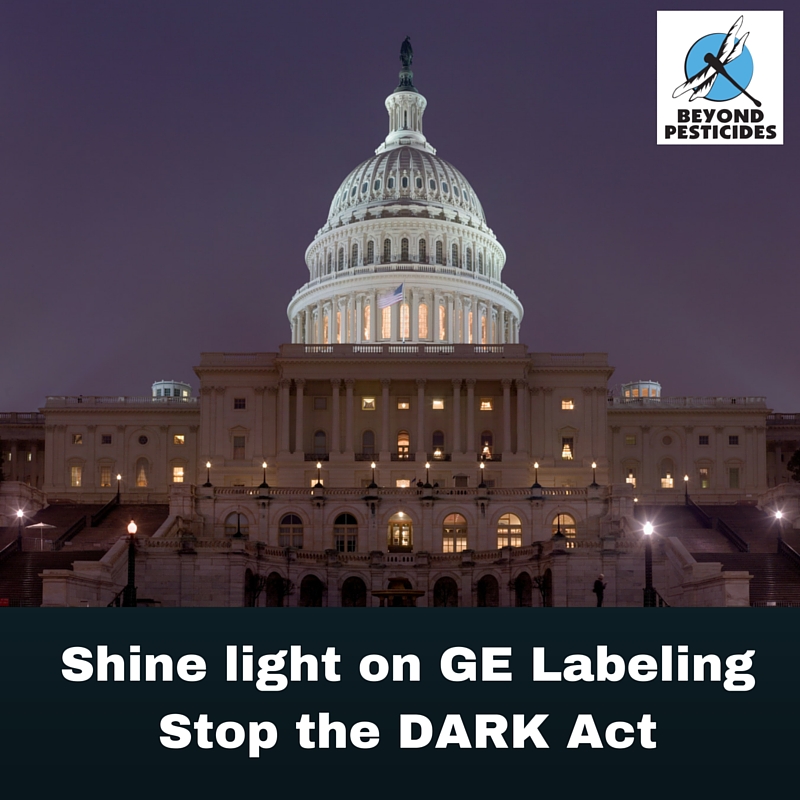09
Mar
Senate Democrats Introduce Bill Requiring GE Food Labeling, Includes Preemption of States
(Beyond Pesticides March 9, 2016) Last week, Senators Jeff Merkley (OR), Patrick Leahy (D-VT), Jon Tester (D-MT), and Dianne Feinstein (D-CA) introduced legislation to require that consumer food packaging displays genetically engineered (GE) ingredient labeling. The Senators’ legislation, the Biotechnology Food Labeling and Uniformity Act (S.2621), presents an alternative to the primarily Republican-backed Biotechnology Labeling Solutions Bill that recently passed the Senate Agriculture Committee on a 14-6 vote. The Biotechnology Labeling Solutions Bill, which embodies several provisions of the much opposed DARK Act, will hide ingredient information from consumers by overturning state GE labeling laws like that of Vermont’s.
“Rather than blocking consumers’ access to information they want, the U.S. Senate should move forward with a solution that  works for businesses and consumers alike,” said Senator Merkley. “There is a way to give consumers the information they are asking for without placing unfair or conflicting requirements on food producers. This legislation provides the common-sense pathway forward.”
works for businesses and consumers alike,” said Senator Merkley. “There is a way to give consumers the information they are asking for without placing unfair or conflicting requirements on food producers. This legislation provides the common-sense pathway forward.”
The Biotechnology Food Labeling and Uniformity Act will allow American consumers to see whether a food has been prepared with GE ingredients, while offering food manufacturers several options for including this information on or near the ingredients list. This framework meets the needs of consumers, the vast majority of whom support labeling according to polls, and producers, who worry that a patchwork of state labeling laws would be costly and difficult to comply with and confusing for consumers.
Specifically, the Biotechnology Food Labeling Uniformity Act will amend the Food Drug and Cosmetic Act to require manufacturers to disclose the presence of GE ingredients on the Nutrition Fact Panel in one of four ways:
- Manufacturers may use a parenthesis following the relevant ingredient to indicate that this ingredient is “Genetically Engineered.”
- Manufacturers may identify GE ingredients with an asterisk and provide an explanation at the bottom of the ingredients list.
- Manufacturers may simply apply a catch all statement at the end of the ingredient list stating the product was “produced with genetic engineering.”
- The FDA would have the authority to develop a symbol, in consultation with food manufacturers, which would clearly and conspicuously disclose the presence of GE ingredients on packaging.
None of these options will require front panel disclosures or “warning” statements intending to disparage GE ingredients.
“This bill is an important step forward to give consumers a uniform national mandatory label, and it seeks to address the needs of food producers by giving them a suite of options to comply with a mandatory national label,” said Senator Leahy. “I believe that until a national mandatory label like this is enacted, Congress should not preempt state laws, like Vermont’s Act 120.”
Despite the clear requirement that food labels will under 2621, if passed, will require disclosure of genetically engineered ingredients, the legislation clearly preempts state labeling authority with the following language. “SEC. 4. FEDERAL PREEMPTION. (a) IN GENERAL.””No State or political subdivision of a State shall impose different or additional requirements to state the presence of the same genetically engineered food or ingredients covered by this Act under the laws, regulations, requirements, or standards of such 16 State or political subdivision of a State.”
Those who argue for federal preemption of state environmental or public health laws creates needed uniformity. However, typically, states do not exceed federal standards unless there is a weakness in the public health or environmental protections. Throughout the history of pesticide regulation by the federal government, action from time-to-time, is preceded by state action. Pesticides, such as DDT, DBCB, chlordane, EDB, and others were first banned by states, followed by federal action. Similarly, states have adopted requirements for posting and notice, school integrated pest management, field reentry restrictions for farmworkers, and other standards that more stringent than federal law. In fact, because the federal pesticide law has upheld the right of states to exceed federal standards for pesticide use, stronger federal law has resulted over time. As a result, Beyond Pesticides has maintained that it is essential to uphold the basic principle that states and localities must not have their authority to adopt more restrictive standards preempted by the federal government. The role of the federal government is too establish a regulatory floor, not a ceiling.
In the case of this legislation, states, based on the science may want to issue a warning on food labeling, whereas S.2621 requires language that states that the product is produced with genetically engineered ingredients. It is expected that manufacturers will us their websites to exclaim the safety of GE ingredients. Campbell Soup has indicated support for labeling, but intends to describe the safety of GE ingredients.
Beyond Pesticides believes that consumers have a right to know whether the foods they buy contain GE ingredients not only because of concerns over the safety of eating GE food, but also because of the direct and indirect effects of GE agriculture on the environment, wildlife, and human health. GE agriculture is associated with the increased use of herbicides —particularly glyphosate, the active ingredient in Roundup— that crops are developed to tolerate. In light of the recent findings by International Agency for Research on Cancer’s (IARC) that glyphosate is a human carcinogen based on laboratory animal test data, consumers have even more cause for concern about the health risks that these products pose.
To join Beyond Pesticides in our fight to promote GE labeling, voice your opposition to the DARK Act and let your elected officials know you support for legislation like the Biotechnology Labeling Food Labeling and Uniformity Act.
All unattributed positions and opinions in this piece are those of Beyond Pesticides.
Source: Senator Merkley Press Release










